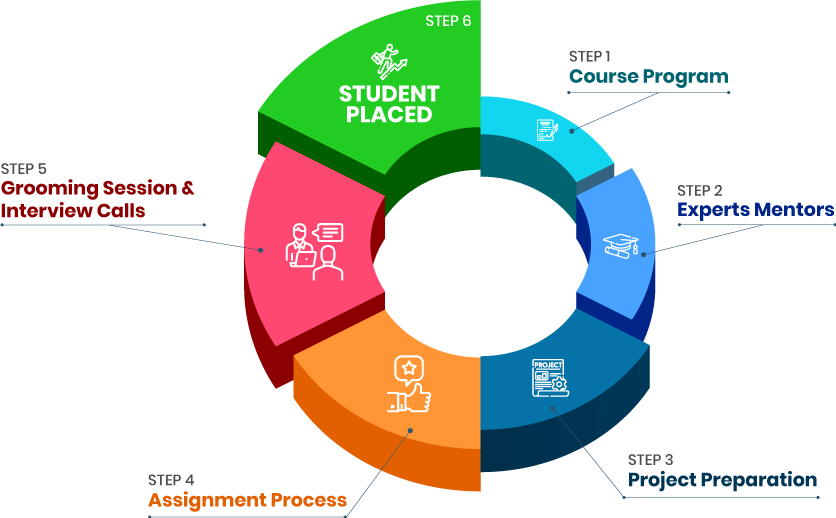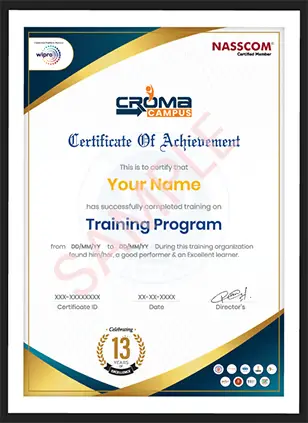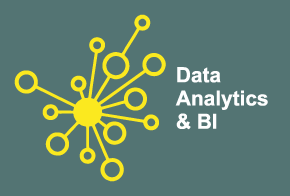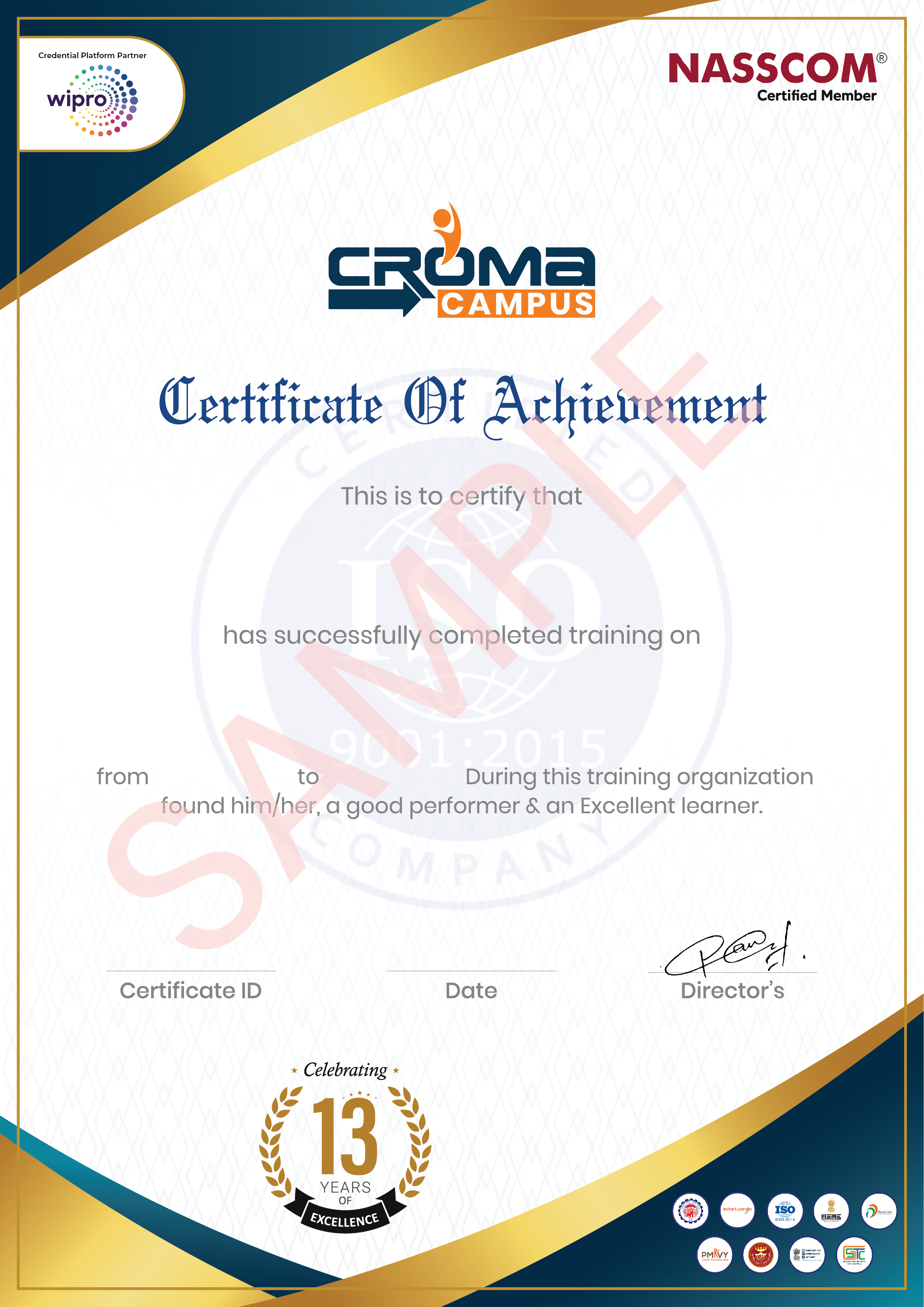- Looking for the top provider of a Data Analysis Course in Kolkata that offers value for money Your search ends here! Croma Campus presents the premier Data Analytics Training in Kolkata, meticulously crafted by our expert team to elevate your skills and boost your proficiency, enabling you to apply them confidently in your workplace.
- Why Choose Croma Campus for Your Data Analytics Course in Kolkata
- Regardless of your background, our Data Analytics Course in Kolkata provides a holistic training approach. Whether you come from an IT background or not, our program is designed to offer comprehensive training to all participants.
- Don't delay. Sign up for the best Data Analytics Certification in Kolkata and become a certified professional. Start your journey with Croma Campus today and unlock your potential like never before!
In-Depth Learning: Achieve a comprehensive understanding of data analysis with our immersive curriculum.
Quality Educational Resources: Gain access to top-notch learning materials and knowledge resources that will enhance your essential skills.
Career Advancement: Our Data Analytics Course is designed to kick-start your exceptional career journey.
Practical Experience: Learn through real-life case studies and hands-on practice to fully grasp the concepts.
Decision-Making Skills: Discover how enterprises leverage data in their business processes to make informed decisions.
- Our Data Analysis Training in Kolkata equips you with a comprehensive understanding of data analysis. Here are the primary objectives:
Gain Expertise in Data Analysis Concepts: Our Data Analysis Course in Kolkata ensures you become proficient in key data analysis concepts and methodologies.
Derive Valuable Insights: Learn to extract valuable insights from data, uncovering hidden patterns, market trends, unknown correlations, and customer preferences.
Improve Your Analytical Skills: Enhance your analytical skills and understand various data analytics terminologies.
Master Open-Source Tools: Get hands-on experience with open-source data analytics tools like R Studio and Spotfire.
Blend of Theory and Practice: Benefit from a balanced mix of theoretical knowledge and practical applications.
Advanced Learning Opportunities: After mastering the basics, delve into advanced concepts of R Studio, Tableau, Spotfire, and statistical analysis.
- Upon completing the Data Analyst Course in Kolkata, you can anticipate competitive salary packages in the field of data analysis. Here are the typical salary expectations:
- Factors Influencing Salary:
- Investing in a Data Analyst Course in Kolkata is a valuable step towards a rewarding and lucrative career in data analysis.
Entry-Level Data Analyst: Fresh graduates or professionals transitioning into data analysis can expect an average salary ranging from 3,00,000 to 5,00,000 per annum.
Mid-Level Data Analyst: With a few years of experience, data analysts can earn between 5,00,000 to 8,00,000 per annum.
Senior Data Analyst: Experienced professionals with significant expertise in data analysis can command salaries ranging from 8,00,000 to 12,00,000 or more per annum.
Specialized Roles: Data analysts specializing in advanced areas such as machine learning, big data, or specific industry sectors can expect higher salary packages, often exceeding 12,00,000 per annum.
Industry: Salaries can vary based on the industry, with finance, healthcare, and technology sectors often offering higher compensation.
Location: While Kolkata offers competitive salaries, data analysts in metropolitan cities like Mumbai, Bangalore, and Delhi may earn higher due to the cost of living and demand.
Skills and Certifications: Additional certifications and specialized skills can significantly boost your salary prospects.
- Completing a Data Analyst Course in Kolkata can significantly boost your career prospects. Heres a compact overview of potential career growth:
- Entry-Level Positions:
- Mid-Level Positions:
- Senior-Level Positions:
- Specialized Roles:
- Leadership Positions:
- Enhancing Your Career:
- Investing in a Data Analyst Course in Kolkata opens up diverse opportunities for career growth and advancement.
Junior Data Analyst: Handle data collection, basic analysis, and report generation.
Business Intelligence Analyst: Analyse data to support business decisions using BI tools.
Data Analyst: Work on complex data analysis and predictive models.
Data Scientist: Apply advanced statistical and machine learning techniques.
Data Engineer: Build and maintain data pipelines and ensure data quality.
Senior Data Analyst: Lead projects and mentor junior analysts.
Analytics Manager: Manage teams and align data projects with business goals.
Data Architect: Design and manage data system architecture.
Machine Learning Engineer: Develop and deploy machine learning models.
Big Data Analyst: Analyse large datasets using big data technologies.
Chief Data Officer (CDO): Oversee data strategy and governance.
Director of Analytics: Lead the analytics division and drive data initiatives.
Certifications: Obtain additional certifications for career advancement.
Networking: Engage with professional networks and communities.
Continuous Education: Stay updated with the latest trends and technologies.
- Data analytics course in Kolkata is popular due to the following reasons.
Growing IT and Business Sector: Kolkatas expanding IT and business sectors drive demand for data analytics professionals.
High Demand for Skilled Analysts: Increasing adoption of data analytics by businesses boosts the need for skilled analysts.
Competitive Salaries: Data analytics professionals in Kolkata enjoy attractive salary packages.
Reputable Training Institutes: The city hosts esteemed institutes offering quality data analytics training.
Career Advancement: Training opens up numerous opportunities for career growth in various industries.
Expert Instructors: Programs feature experienced industry professionals providing practical insights.
Networking Opportunities: Kolkata has a vibrant data professional community, fostering networking and collaboration.
- Upon completing your Data Analytics Training, you will be equipped to perform several key job roles and responsibilities:
Master Data Analytics Concepts: A professional should be well-versed in all data analytics concepts and related skills.
Understand Data Analytics Terminologies: You must be familiar with various data analytics terminologies such as acquisition, manipulation, evaluation, and experimentation.
Implement Programming Skills: Implement basic R programming and Tableau programming, and familiarize yourself with open-source data analytics tools.
Pursue Advanced Training: Apply for advanced-level training in areas like advanced analytics, R Studio, Tableau, Spotfire, and statistics.
Industry-Ready Skills: Our Data Analytics Course, which includes projects, webinars, and assignments, will make you industry-ready, enabling you to secure a high-paying job at a top-notch company.
- Upon completing the Data Analytics Training in Kolkata, you will receive a certification that assures potential employers of your skills and expertise. Enrolling in our Data Analytics Course and successfully finishing the training is a smart move.
Become a certified data analytics expert today.
Top companies such as Google, Intuit, Cisco Systems, Facebook, Apple, Capital, Maruti, and more are seeking professionals like you.
Our Data Analytics Course includes specialized interview training sessions to prepare you for job interviews.
Equip yourself to tackle any challenges that come your way.
- Our Data Analytics Certification course in Kolkata provides in-depth knowledge of all relevant data analytics tools and techniques tailored to meet learners' specific needs.
Stand out to potential recruiters and get hired immediately.
Our experts also offer support with valuable interview tips.
Enhance your value in today's competitive job market.
Recognized globally, this certification opens up opportunities to work abroad.
Gain the necessary knowledge to successfully pass any certification exam.
- You May Also Read:
Why Should You Learn Data Analytics?
By registering here, I agree to Croma Campus Terms & Conditions and Privacy Policy
 Course Duration
Course Duration
180 Hrs.
Flexible Batches For You
26-Apr-2025*
- Weekend
- SAT - SUN
- Mor | Aft | Eve - Slot
28-Apr-2025*
- Weekday
- MON - FRI
- Mor | Aft | Eve - Slot
30-Apr-2025*
- Weekday
- MON - FRI
- Mor | Aft | Eve - Slot
26-Apr-2025*
- Weekend
- SAT - SUN
- Mor | Aft | Eve - Slot
28-Apr-2025*
- Weekday
- MON - FRI
- Mor | Aft | Eve - Slot
30-Apr-2025*
- Weekday
- MON - FRI
- Mor | Aft | Eve - Slot
Course Price :
Timings Doesn't Suit You ?
We can set up a batch at your convenient time.
Program Core Credentials
Trainer Profiles
Industry Experts
Trained Students
10000+
Success Ratio
100%
Corporate Training
For India & Abroad
Job Assistance
100%
Batch Request
FOR QUERIES, FEEDBACK OR ASSISTANCE
Contact Croma Campus Learner Support
Best of support with us
CURRICULUM & PROJECTS
Data Analytics Certification Training
- Creation of Excel Sheet Data
- Range Name, Format Painter
- Conditional Formatting, Wrap Text, Merge & Centre
- Sort, Filter, Advance Filter
- Different type of Chart Creations
- Auditing, (Trace Precedents, Trace Dependents)Print Area
- Data Validations, Consolidate, Subtotal
- What if Analysis (Data Table, Goal Seek, Scenario)
- Solver, Freeze Panes
- Various Simple Functions in Excel(Sum, Average, Max, Min)
- Real Life Assignment work
- Advance Data Sorting
- Multi-level sorting
- Restoring data to original order after performing sorting
- Sort by icons
- Sort by colours
- Lookup Functions
- Lookup
- VLookup
- HLookup
- Subtotal, Multi-Level Subtotal
- Grouping Features
- Column Wise
- Row Wise
- Consolidation With Several Worksheets
- Filter
- Auto Filter
- Advance Filter
- Printing of Raw & Column Heading on Each Page
- Workbook Protection and Worksheet Protection
- Specified Range Protection in Worksheet
- Excel Data Analysis
- Goal Seek
- Scenario Manager
- Data Table
- Advance use of Data Tables in Excel
- Reporting and Information Representation
- Pivot Table
- Pivot Chat
- Slicer with Pivot Table & Chart
- Generating MIS Report In Excel
- Advance Functions of Excel
- Math & Trig Functions
- Text Functions
- Lookup & Reference Function
- Logical Functions & Date and Time Functions
- Database Functions
- Statistical Functions
- Financial Functions
- Functions for Calculation Depreciation
- SQL Server 2019 Installation
- Service Accounts & Use, Authentication Modes & Usage, Instance Congurations
- SQL Server Features & Purpose
- Using Management Studio (SSMS)
- Conguration Tools & SQLCMD
- Conventions & Collation
- SQL Database Architecture
- Database Creation using GUI
- Database Creation using T-SQL scripts
- DB Design using Files and File Groups
- File locations and Size parameters
- Database Structure modications
- SQL Server Database Tables
- Table creation using T-SQL Scripts
- Naming Conventions for Columns
- Single Row and Multi-Row Inserts
- Table Aliases
- Column Aliases & Usage
- Table creation using Schemas
- Basic INSERT
- UPDATE
- DELETE
- SELECT queries and Schemas
- Use of WHERE, IN and BETWEEN
- Variants of SELECT statement
- ORDER BY
- GROUPING
- HAVING
- ROWCOUNT and CUBE Functions
- Table creation using Constraints
- NULL and IDENTITY properties
- UNIQUE KEY Constraint and NOT NULL
- PRIMARY KEY Constraint & Usage
- CHECK and DEFAULT Constraints
- Naming Composite Primary Keys
- Disabling Constraints & Other Options
- Benets of Views in SQL Database
- Views on Tables and Views
- SCHEMA BINDING and ENCRYPTION
- Issues with Views and ALTER TABLE
- Common System Views and Metadata
- Common Dynamic Management views
- Working with JOINS inside views
- Need for Indexes & Usage
- Indexing Table & View Columns
- Index SCAN and SEEK
- INCLUDED Indexes & Usage
- Materializing Views (storage level)
- Composite Indexed Columns & Keys
- Indexes and Table Constraints
- Primary Keys & Non-Clustered Indexes
- Why to use Stored Procedures
- Types of Stored Procedures
- Use of Variables and parameters
- SCHEMABINDING and ENCRYPTION
- INPUT and OUTPUT parameters
- System level Stored Procedures
- Dynamic SQL and parameterization
- Scalar Valued Functions
- Types of Table Valued Functions
- SCHEMABINDING and ENCRYPTION
- System Functions and usage
- Date Functions
- Time Functions
- String and Operational Functions
- ROW_COUNT
- GROUPING Functions
- Why to use Triggers
- DML Triggers and Performance impact
- INSERTED and DELETED memory tables
- Data Audit operations & Sampling
- Database Triggers and Server Triggers
- Bulk Operations with Triggers
- Cursor declaration and Life cycle
- STATIC
- DYNAMIC
- SCROLL Cursors
- FORWARD_ONLY and LOCAL Cursors
- KEYSET Cursors with Complex SPs
- ACID Properties and Scope
- EXPLICIT Transaction types
- IMPLICIT Transactions and options
- AUTOCOMMIT Transaction and usage
- Overview of BI concepts
- Why we need BI
- Introduction to SSBI
- SSBI Tools
- Why Power BI
- What is Power BI
- Building Blocks of Power BI
- Getting started with Power BI Desktop
- Get Power BI Tools
- Introduction to Tools and Terminology
- Dashboard in Minutes
- Interacting with your Dashboards
- Sharing Dashboards and Reports
- Power BI Desktop
- Extracting data from various sources
- Workspaces in Power BI
- Data Transformation
- Query Editor
- Connecting Power BI Desktop to our Data Sources
- Editing Rows
- Understanding Append Queries
- Editing Columns
- Replacing Values
- Formatting Data
- Pivoting and Unpivoting Columns
- Splitting Columns
- Creating a New Group for our Queries
- Introducing the Star Schema
- Duplicating and Referencing Queries
- Creating the Dimension Tables
- Entering Data Manually
- Merging Queries
- Finishing the Dimension Table
- Introducing the another DimensionTable
- Creating an Index Column
- Duplicating Columns and Extracting Information
- Creating Conditional Columns
- Creating the FACT Table
- Performing Basic Mathematical Operations
- Improving Performance and Loading Data into the Data Model
- Introduction to Modelling
- Modelling Data
- Manage Data Relationship
- Optimize Data Models
- Cardinality and Cross Filtering
- Default Summarization & Sort by
- Creating Calculated Columns
- Creating Measures & Quick Measures
- What is DAX
- Data Types in DAX
- Calculation Types
- Syntax, Functions, Context Options
- DAX Functions
- Date and Time
- Time Intelligence
- Information
- Logical
- Mathematical
- Statistical
- Text and Aggregate
- Measures in DAX
- Measures and Calculated Columns
- ROW Context and Filter Context in DAX
- Operators in DAX - Real-time Usage
- Quick Measures in DAX - Auto validations
- In-Memory Processing DAX Performance
- Installation and Working with Python
- Understanding Python variables
- Python basic Operators
- Understanding the Python blocks.
- Python Comments, Multiline Comments.
- Python Indentation
- Understating the concepts of Operators
- Arithmetic
- Relational
- Logical
- Assignment
- Membership
- Identity
- Statistics
- Categorical Data
- Numerical Data
- Mean
- Median
- Mode
- Outliers
- Range
- Interquartile range
- Correlation
- Standard Deviation
- Variance
- Box plot
- Pandas
- Read data from Excel File using Pandas More Plotting, Date Time Indexing and writing to les
- How to get record specic records Using Pandas Adding & Resetting Columns, Mapping with function
- Using the Excel File class to read multiple sheets More Mapping, Filling Nonvalue’s
- Exploring the Data Plotting, Correlations, and Histograms
- Getting statistical information about the data Analysis Concepts, Handle the None Values
- Reading les with no header and skipping records Cumulative Sums and Value Counts, Ranking etc
- Reading a subset of columns Data Maintenance, Adding/Removing Cols and Rows
- Applying formulas on the columns Basic Grouping, Concepts of Aggre gate Function
- Complete Understanding of Pivot Table Data Slicing using iLoc and Loc property (Setting Indices)
- Under sting the Properties of Pivot Table in Pandas Advanced Reading CSVs/HTML, Binning, Categorical Data
- Exporting the results to Excel Joins
- Python | Pandas Data Frame Inner Join
- Under sting the properties of Data Frame Left Join (Left Outer Join)
- Indexing and Selecting Data with Pandas Right Join (Right Outer Join)
- Pandas | Merging, Joining and Concatenating Full Join (Full Outer Join)
- Pandas | Find Missing Data and Fill and Drop NA Appending Data Frame and Data
- Pandas | How to Group Data How to apply Lambda / Function on Data Frame
- Other Very Useful concepts of Pandas in Python Data Time Property in Pandas (More and More)
+ More Lessons
Mock Interviews

Phone (For Voice Call):
+91-971 152 6942WhatsApp (For Call & Chat):
+919711526942SELF ASSESSMENT
Learn, Grow & Test your skill with Online Assessment Exam to
achieve your Certification Goals

FAQ's
The course covers comprehensive data analytics tools, techniques, and practical applications.
It equips you with in-demand skills, making you job-ready for various data-related roles.
Yes, the course includes job placement support and interview preparation.
Yes, the course is designed to cater to learners from diverse professional backgrounds.
You can apply for roles such as data analyst, data engineer, data scientist, and business intelligence analyst.

- - Build an Impressive Resume
- - Get Tips from Trainer to Clear Interviews
- - Attend Mock-Up Interviews with Experts
- - Get Interviews & Get Hired
If yes, Register today and get impeccable Learning Solutions!

Training Features
Instructor-led Sessions
The most traditional way to learn with increased visibility,monitoring and control over learners with ease to learn at any time from internet-connected devices.
Real-life Case Studies
Case studies based on top industry frameworks help you to relate your learning with real-time based industry solutions.
Assignment
Adding the scope of improvement and fostering the analytical abilities and skills through the perfect piece of academic work.
Lifetime Access
Get Unlimited access of the course throughout the life providing the freedom to learn at your own pace.
24 x 7 Expert Support
With no limits to learn and in-depth vision from all-time available support to resolve all your queries related to the course.
Certification
Each certification associated with the program is affiliated with the top universities providing edge to gain epitome in the course.
Showcase your Course Completion Certificate to Recruiters
-
Training Certificate is Govern By 12 Global Associations.
-
Training Certificate is Powered by “Wipro DICE ID”
-
Training Certificate is Powered by "Verifiable Skill Credentials"



































 Master in Cloud Computing Training
Master in Cloud Computing Training